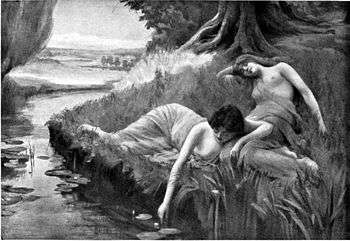Valravn
In Danish folklore, a valravn (Danish "raven of the slain") is a supernatural raven. The ravens appear in traditional Danish folksongs, where they are described as originating from ravens who eat the bodies of the dead on the battlefield, as capable of turning into the form of a knight after eating the entire heart of a child, and, alternately, as half-wolf and half-raven creatures.
Folklore
According to Danish folklore recorded in the late 1800s, when a king or chieftain was killed in battle and not found and buried, ravens came and ate him. The ravens became valravne. The valravne that ate the king's heart gained human knowledge and could perform great malicious acts, could lead people astray, had superhuman powers, and were "terrible animals".[1]
In another account, a valravn is described as a peaceless soul in search of redemption that flies by night (but never day) and can only free itself from its animal countenance by consuming the blood of a child. This is reflected in a Danish traditional song that describes how, after refusing offers of riches, the Valravn makes an agreement with a maiden to take her to her betrothed after she promises the valravn her first-born son. After the agreement, the valravn flies away. In time, the couple have a child and the Valravn returns, and asks the maiden if she has forgotten her promise. The valravn takes the child away, and tears into the chest of his won wager and consumes the blood contained within the child's heart. As a result, the valravn transforms into a knight. This traditional song was reinterpreted by the electro-folk band Sorten Muld and became a hit for them in 1997, under the title Ravnen.
Other accounts describe valravns as monsters that are half-wolf and half-raven.[2]
Interpretations and theories
According to 19th century scholar Jacob Grimm, the "vilde ravn or vilde valravn" ("wild raven or wild Valravn") take "exactly the place of the diabolical trold" in Danish folk songs. Grimm proposes an Old High German equivalent to the Danish valravn; *walahraban.[3]
Modern influence
The valravn has inspired an early 20th-century book of short stories[4] and some modern popular culture references, such as a modern musical group from the Faroe Islands called Valravn who play a hybrid of traditional and electronic music;[5] Valravn, a Danish Germanic Neopagan magazine published in 24 issues from 2002 to 2007;[6] and mentions in Danish children's books.[7]
Roller coaster
Cedar Point, an amusement park, opened a Bolliger & Mabillard dive coaster on May 6th 2016 named Valravn (roller coaster).
See also
Notes
References
- Bjerre, Birgit (1991). Skovtrolden i Lerbjergskoven. Høst & Søn. ISBN 87-14-19005-2
- Grimm, Jacob (James Steven Stallybrass Trans.) (2004). Teutonic Mythology: Translated from the Fourth Edition with Notes and Appendix by James Stallybrass. Volume III. Dover Publications. ISBN 0-486-43548-2
- Kristensen, Evald Tang (1980). Danske Sagn: Som De Har Lyd I Folkemunde. Nyt Nordisk Forlag Arnold Busck, Copenhagen. ISBN 87-17-02791-8
- Olrik, Axel; Falbe, Ida Hansen. (1908) Danske Folkeviser. Gyldendal. Vol. 1.
- Stuckenberg, Viggo Henrik Fog (1908). Valravn og Sol: smaa romaner. Gyldendal.
